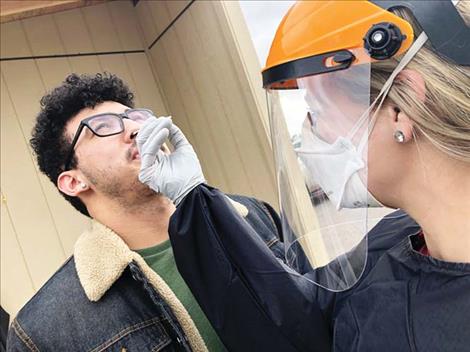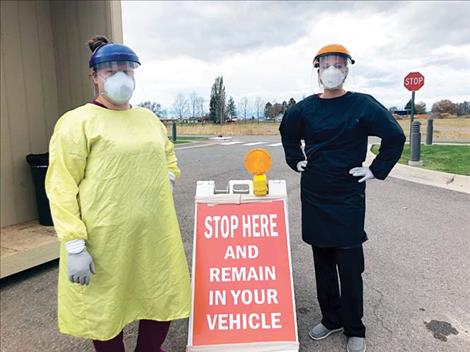COVID-19 numbers surge in Lake County
Hey savvy news reader! Thanks for choosing local.
You are now reading
1 of 3 free articles.
LAKE COUNTY — As I was preparing to write about the impact of COVID-19 on St. Luke Hospital in Ronan, the story suddenly became very personal. My sister, who was diagnosed with the virus over three weeks ago, took an abrupt turn for the worse and was admitted to St. Luke Wednesday afternoon.
The past few days have been a roller coaster as her conditions worsened and then, over the weekend, began to stabilize.
At the same time, the daily tally of new COVID cases careened upward across the state, reaching over 1,000 positive results daily. Locally, in the past week, Lake County posted 126 positives for a total of 270 active cases by Sunday and has seen seven deaths since the pandemic started in March.
I spoke to St. Luke CEO Steve Todd and nursing director Abigail Byers about how their facility and related network of community clinics are coping with the dramatic upswing.
“A day at a time,” said Todd. “It’s certainly a challenge but we have a great staff that’s stepping up, filling in, helping out, and remaining flexible as we deal with each new challenge.”
Since last March, the hospital and its staff have been preparing for just such an eventuality, laying plans, educating healthcare workers, executing drills, and making sure that supplies of personal protective equipment are adequate.
Still, it’s a stretch for the 25-bed facility. In the past month, the hospital’s COVID unit has mushroomed from two beds to eight. The unit is segregated from the rest of the hospital with its own nursing staff, a physician who treats only COVID patients, and a negative air-pressure supply that makes sure the airflow – and hence the virus – is kept away from the rest of the facility. Adding to the complexity, equipment used to treat COVID patients has specific cleaning and storage requirements to prevent cross-contamination.
“Many COVID patients are a lot more critical (in condition),” said Byers. “It’s a constant reminder of the equipment and skill level it takes to care for those patients – and making sure we have that ready and available for them.”
Both St. Luke officials describe COVID care as “ever-evolving,” as physicians and researchers learn more about this new virus and how it can impact patients. For example, “proning,” or placing patients on their stomachs to help ease chest congestion, is a fairly new approach.
“We were not really thinking about taking someone who really doesn’t feel well and is short of breath and trying to help them lay on their stomach,” said Byers.
Proning is among the techniques used to avoid intubating patients in acute respiratory distress and placing them on a ventilator, which research now shows has detrimental long-term effects.
“As science has evolved with coronavirus, we’ve developed new techniques and interventions as well,” said Byers.
And that, adds Todd, is “the small silver lining” of having the surge in cases arrive now, as opposed to last spring when so little was known about the virus.
The surge that has gripped the entire state is also straining St. Luke’s resources. While he lauds the resiliency of his staff, “we’re trying to be mindful of ways in which we can prevent them from having too much fatigue with this.”
In addition, staff members have tested positive for COVID, which has reduced manpower. “Because we don’t have huge bench strength to begin with, our bench ranks are even lower,” Todd said. That in turn makes it harder to deliver more routine medical care in the clinics.
Byers worries about the demands the surge has placed on the nursing team. “I see my staff are tired and that concerns me, so keeping their spirits lifted is really important, and dealing with emotions is too,” she said. “We go outside these four walls and it’s difficult out there, and it’s difficult in here.”
“These patients have high needs and we need to be there for them,” she adds. “And taking care of ourselves as caregivers is really important too.”
Still, the staff keeps stepping up across the board and in every department. That’s a level of dedication that my sister has experienced first hand, as her physicians consistently make time to answer the flurry of questions from concerned family members.
“I feel totally confident in this team,” she said. “I feel like I’m better off in this environment with these young, smart doctors. There’s no way I’d get the attention I’m getting here in a larger setting.”
Todd is equally confident in his team. “They’re amazing. They come when they’re called, they’re doing incredible meaningful work, and they rise to the challenge. But that can’t last forever.”
Another silver lining is the unprecedented cooperation the virus has sparked among healthcare providers across western Montana. During the initial lockdown in March, Providence St. Joseph Hospital in Polson initiated a COVID task force comprised of both hospitals, the county health department, the Confederated Salish and Kootenia Tribes and Emergency Management Services.
“We sit on a call every Monday and Friday just talking about our numbers – what we’re learning and what we’re doing,” said Todd. “So, that’s been just great support.”
On Tuesdays, all the CEOs of hospitals in western Montana convene on a call, which has helped them share valuable resources. When St. Luke was low on test swabs, Marcus Daly Hospital in Hamilton and Providence St. Joseph both sent same-day shipments, and when Polson Health and Rehab was experiencing a PPE shortage, St. Luke sent a supply of masks up to them.
“Nobody wants to feel like they’re on an island in this situation,” said Todd. “Across the board and across the state, it has led to a lot of cooperative efforts, which is really good to see and, in this situation, much needed.”
On the nursing side, Byers participates in a daily bed tally for the western region, reporting on bed capacity and needs. She also works closely with her counterparts in Polson and Kalispell, “just to share things back and forth and gauge what we’re doing here.”
The medical staff also has a supportive relationship with doctors around the region. “Our providers have reached out to providers to the north and south of us to help guide us through, give us ideas and help us make the decision of whether we need to intubate or transport a patient to them,” said Byers.
“All the hospitals have been very supportive in helping us through those clinical and critical decision-making processes,” she adds.
While St. Luke has transported a few critically ill patients to larger facilities, the staff has also grown more adept at treating patients in-house, thanks, in part, to the success its cardiopulmonary and anesthesia departments have had in preventing intubation. “We’re working really hard on the prevention aspect because we know there are lasting effects from ventilation,” Byers explains.
During the surge, as hospitals in larger areas fill up, it’s even more crucial that St. Luke take care of its own. “That’s part of the reason we’re having to take our COVID patients and care for them here,” said Todd. Kalispell and Missoula facilities “have got the same kind of challenges but at an even larger level.”
Which brings him to the crucial role that the community plays in the pandemic. “If we don’t see a leveling off and decrease of this right now, it’s definitely concerning,” Todd said. “The burden it places on our healthcare system and staff is not a sustainable situation. We have to see it get better.”
With the holidays looming and winter weather forcing us all to spend more time indoors, the recipe for bringing COVID under control rests squarely with each of us.
“Everyone has fatigue around masking but gosh darn it, we know it works,” said Todd. “People need to use their masks out in the community, be vigilant with their social distancing and maintain all the hygienic practices we have.”
Healthcare providers also urge people to get flu shots this season “so we don’t see an unintended surge in flu cases that add to the burden we already have.”
“We keep reminding our staff that tough times don’t last but tough teams do,” Todd said. “We’ve got a tough team here.”

















